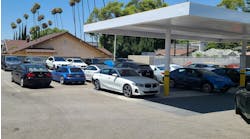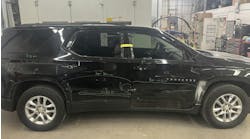The steps you should take when buying a new paint booth for your shop
Is its general condition a little shocking?
I've visited many shops, and the condition of most of the spray booths in them shock me as well. I have a hard time wrapping my head around how poorly most of them I see are maintained, considering the fact that most spray booths cost thousands of dollars. They can range in price from roughly $5,000 to $80,000 dollars. Why is this essential piece of equipment often so overlooked until it breaks down? Maybe because it is, almost without fail, the one piece of equipment in your shop used all day, every day. Booths are used so often, it can be nearly impossible to squeeze in any time for maintenance without greatly affecting shop production.
That's a good excuse anyway. In reality, that's all it is, an excuse and not an acceptable one. This all-important piece of equipment, like any other equipment in your shop, needs proper maintenance and care. But back to my main point.
Now that I have you looking at your booth with fresh eyes, is it time for an upgrade to a new booth, or does your current booth just need a little clean up, and tuning up to service your needs?For many of you, a weekend cleanup and painting will help, but if your booth requires more serious work, you could need to invest a little more time and a few more bucks and buy something new.
Although there are many factors involved in a decision regarding an upgrade of your current spray booth, there are four key factors that need to be considered in every case. They are:
- current/future work volume;
- type of work;
- green philosophy; and
- cost.
Current and future work volume
How many cars a day are you running through your booth? If you are only painting one, or maybe two cars a day, you will have different needs in a booth than a shop that paints 10 cars a day. A low-volume shop may not need a downdraft or a baking booth, whereas a high-volume shop definitely will.Most shops currently use a series of metrics to help them determine their sales volume at any given time in a month. Following these metrics closely will help project potential sales in a given time frame or help predict potential sales in relation to monthly goals. This may seem like a topic for another article, however, it's important to know, at a minimum, the basics of this process before continuing. If you don't know how many cars you should be painting a day, you can look at some really simple formulas to determine this.
To determine a rough number, take your monthly goal number, and divide it by your average repair order (RO) sales amount. For example, say your goal is $50,000 in gross sales a month and your average RO is $2,000. Using this formula, you will have to deliver 25 cars a month, at $2,000 a car to hit your goal. Next, divide 25 by the number of working days in the month. If there are 21 working days in the month, you would have to, on average, deliver 1.1 cars a day.
With a production number this low, a shop would probably only need a semi-downdraft or even a cross-flow booth without baking capability. The amount of production you expect to do relates directly to your equipment needs. If you are planning on painting 10 cars a day, your shop will absolutely need baking capability. If you are planning on increasing volume, and you don't have baking capability, you should be thinking of a booth upgrade.
Keep in mind, there are many "baking" booths in the marketplace today. Most utilize the conventional gas or propane fired 1.5 million BTU burners, but some utilize UV lamps to cure the finish. If you are in a rural area where gas is not easy to get, or you want to consider an alternative, UV might work for you. You might have seen some UV refinish products filtering in to shops over the past few years. They are gathering steam and gaining greater and greater acceptance and are "user friendly."
UV lighting can be added to an existing booth, but without professional installation, lamp type and placement, the end result will not be optimum. If you work with a large jobber, they can help you look at your options here.
Type of work
The type of work your shop does will influence your booth needs as well. Are you doing high-line restorations or $600 complete repaints? Do you perform fleet work or work on heavy equipment or farm implements? Obviously, the booth needs for some of these applications will be vastly different. You will need to keep this in mind when buying.
Green philosophy
Fortunately, many of us are becoming better aware of our responsibility to the planet. The use of waterborne finishes in the collision repair industry highlights that point. More than likely, environmental regulations will eventually exist that require shops in all states to use waterborne basecoats. For you, this transition may be years away or much sooner, depending on what part of the country your shop is in.
Using a waterborne refinish system requires lots of changes, including changes in how you use your booth. Waterborne finishes require a great deal of air movement in the booth to help dry the base, almost the opposite of what is required for solvent-based paints. (Keeping your booth clean is really important when you are creating the required air movement.)
In order to create that movement, you will need to install devices like "quads" as they are called, corner-mounted air diffuser systems or ceiling fans in the box itself.
Handheld air movers are available, but they work best on small jobs like bumper covers or fenders, not on larger jobs.
I recently spoke with Alan Borg, from FinishMaster, and he gave me some insight into what his company recommends when converting to waterborne from a traditional solvent system.
"Training is paramount, before any installation is even begun," says Borg, "I recommend an all-in philosophy. By that I mean, you have to be dedicated and ready to remove all of your solvent-based products. It's all waterborne basecoats or nothing. Having both systems side by side, is generally not a good idea."
Borg also said to retrofit an existing booth for use with waterborne products would cost roughly $12,000 to $15,000. Keep in mind that this particular company recommends a 15-horsepower screw type compressor running the paint shop alone when using waterborne finishes. This could add to your expense as well. These air movers, whether using quads or ceiling fans, can use plenum air or booth air as a primary supply. The air is generally heated, but not baking hot.
Force drying waterborne with heat alone will not work effectively. In addition, you will need to upgrade your airline dryers or install one if you are currently not using one. Your application equipment must be replaced as well (this includes spray guns, air hoses, etc.) All waterborne equipment must be kept separate from solvent equipment.
This conversion is expensive, and requires somewhat of a learning curve for all your staff, but you will gain in several areas with waterborne products. Color match is, according to all the major paint manufactures much better with waterborne than with solvent-based systems. Additionally, application speed is increased, raising throughput. In simple terms, using waterborne, once acclimated, will allow you to produce a higher quality product in less time.
Your waste removal cost will drop as well, since you are not disposing of so much solvent, like thinners and reducers. Obviously, another major benefit is the volatile organic compound (VOC) reduction. In a waterborne-only shop, according to Borg, VOCs are generally reduced by 50 percent. That's a win/win proposition.
While retrofitting an older booth may be costly and require some careful consideration, I recommend using waterborne in any new shop being considered. It only makes sense to get out in front of the technology, and impending regulations, and start from day one with the right booth, and system.
According to Borg, a new, properly equipped booth, ready to use with waterborne finishes is about $15,000 to $20,000 more than the cost of a standard booth. The impact of those costs would be minimized by rolling it in with all the new equipment required in a start up. Training would be easier as well.
Cost
Of all the basics, cost for most of us is the most important. I think we all want to produce more, in less time, for less cost. The cost of the box itself is not the only consideration. The booth you choose may require complex installation with additional demolition or concrete work needed. You can survey pricing online, or in brochures, but the only way to get an accurate estimate is to have several companies come to your shop and provide you with a quote.
Again, start by speaking with your paint jobber. The larger jobbers can perform a complete assessment of your entire shop when considering an upgrade. They will measure air flow and air quality. They will look at your volume needs, and shop layout, and put together a program that works best for your special needs.
I would also suggest you get quotes from at least three different booth suppliers. This is an extremely important investment, which must be considered very carefully.
Get the most from your investment
It's very important to maintain your booth. If you are considering an upgrade or a replacement, make sure that you implement a serious maintenance program for your booth. You wouldn't buy a brand new car and never change the oil, would you? It sounds silly, but many shops ignore this simple, but important, task. A well-maintained booth will maximize the return on your investment.




